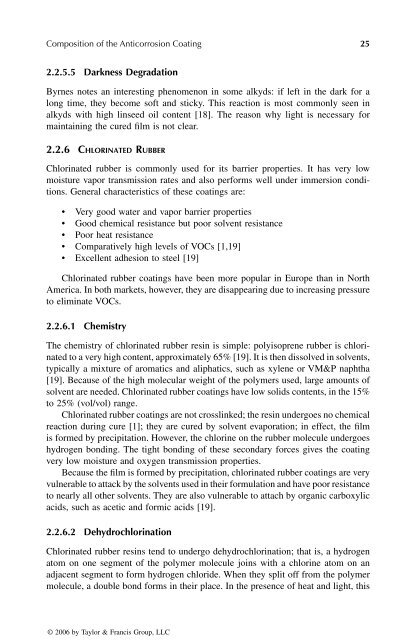© 2006 by Taylor & Francis Group, LLC
© 2006 by Taylor & Francis Group, LLC
© 2006 by Taylor & Francis Group, LLC
You also want an ePaper? Increase the reach of your titles
YUMPU automatically turns print PDFs into web optimized ePapers that Google loves.
Composition of the Anticorrosion Coating 25<br />
2.2.5.5 Darkness Degradation<br />
Byrnes notes an interesting phenomenon in some alkyds: if left in the dark for a<br />
long time, they become soft and sticky. This reaction is most commonly seen in<br />
alkyds with high linseed oil content [18]. The reason why light is necessary for<br />
maintaining the cured film is not clear.<br />
2.2.6 CHLORINATED RUBBER<br />
Chlorinated rubber is commonly used for its barrier properties. It has very low<br />
moisture vapor transmission rates and also performs well under immersion conditions.<br />
General characteristics of these coatings are:<br />
• Very good water and vapor barrier properties<br />
• Good chemical resistance but poor solvent resistance<br />
• Poor heat resistance<br />
• Comparatively high levels of VOCs [1,19]<br />
• Excellent adhesion to steel [19]<br />
Chlorinated rubber coatings have been more popular in Europe than in North<br />
America. In both markets, however, they are disappearing due to increasing pressure<br />
to eliminate VOCs.<br />
2.2.6.1 Chemistry<br />
The chemistry of chlorinated rubber resin is simple: polyisoprene rubber is chlorinated<br />
to a very high content, approximately 65% [19]. It is then dissolved in solvents,<br />
typically a mixture of aromatics and aliphatics, such as xylene or VM&P naphtha<br />
[19]. Because of the high molecular weight of the polymers used, large amounts of<br />
solvent are needed. Chlorinated rubber coatings have low solids contents, in the 15%<br />
to 25% (vol/vol) range.<br />
Chlorinated rubber coatings are not crosslinked; the resin undergoes no chemical<br />
reaction during cure [1]; they are cured <strong>by</strong> solvent evaporation; in effect, the film<br />
is formed <strong>by</strong> precipitation. However, the chlorine on the rubber molecule undergoes<br />
hydrogen bonding. The tight bonding of these secondary forces gives the coating<br />
very low moisture and oxygen transmission properties.<br />
Because the film is formed <strong>by</strong> precipitation, chlorinated rubber coatings are very<br />
vulnerable to attack <strong>by</strong> the solvents used in their formulation and have poor resistance<br />
to nearly all other solvents. They are also vulnerable to attach <strong>by</strong> organic carboxylic<br />
acids, such as acetic and formic acids [19].<br />
2.2.6.2 Dehydrochlorination<br />
Chlorinated rubber resins tend to undergo dehydrochlorination; that is, a hydrogen<br />
atom on one segment of the polymer molecule joins with a chlorine atom on an<br />
adjacent segment to form hydrogen chloride. When they split off from the polymer<br />
molecule, a double bond forms in their place. In the presence of heat and light, this<br />
<strong>©</strong> <strong>2006</strong> <strong>by</strong> <strong>Taylor</strong> & <strong>Francis</strong> <strong>Group</strong>, <strong>LLC</strong>
















